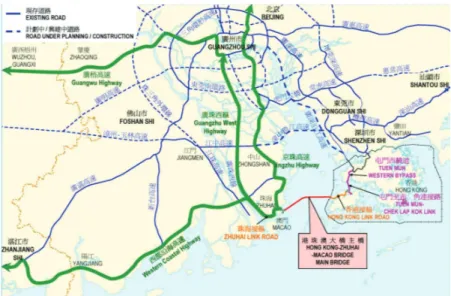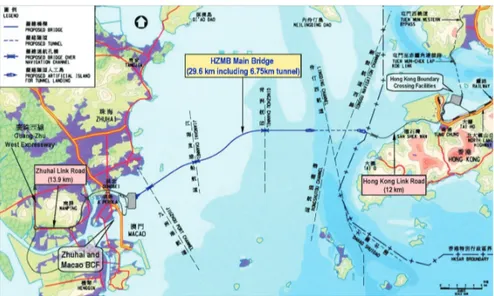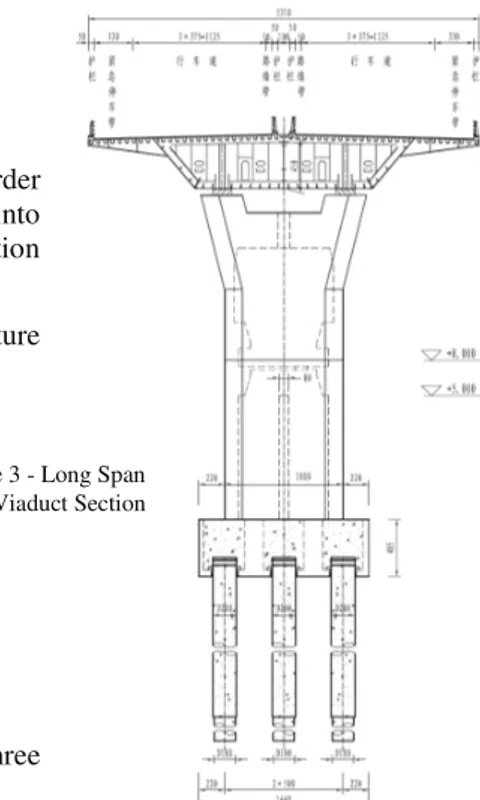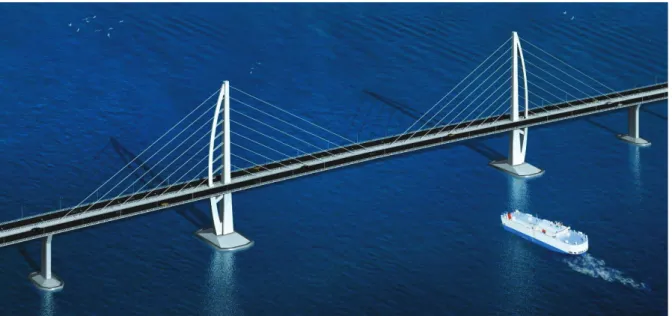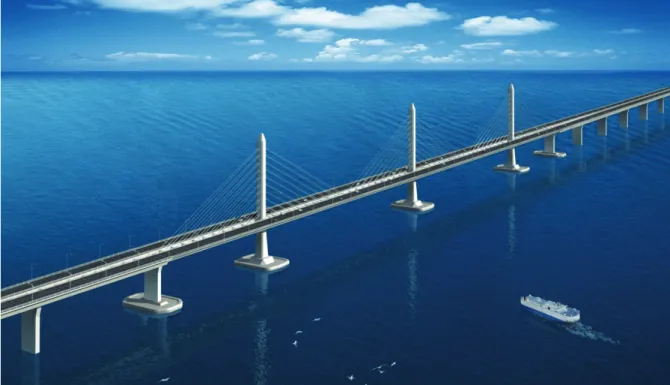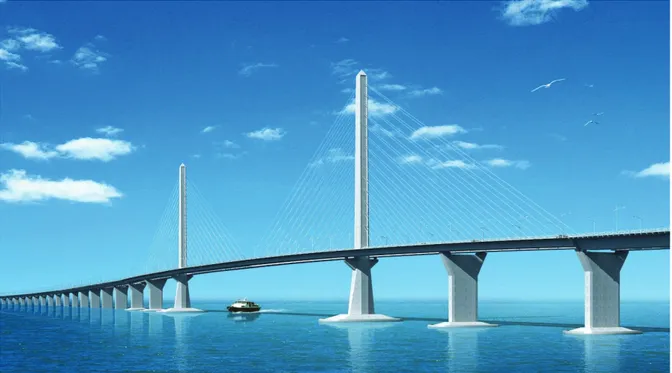The Twelfth East Asia-Pacific Conference on Structural Engineering and Construction
HONG KONG ZHUHAI MACAO LINK
N.HUSSAIN
a, CARLOS WONG
b, MATT CARTER
c,
SAMUEL KWAN
d, TAK-WAH MAK
ea Director and Arup Fellow, Arup, Hong Kong ([email protected]) b Associate, Arup, Hong Kong ([email protected] ) c Associate Director, Arup, Hong Kong ([email protected])
d Associate, Arup, Hong Kong ([email protected]) e Engineer, Arup, Hong Kong ([email protected])
Abstract
The Hong Kong Zhuhai Macao Link will be built across the mouth of the Pearl River Delta linking Hong Kong, Zhuhai and Macao in the south of China. The link will comprise of a dual 3-lane with hardshoulder motorway with a total length of approximately 42km, of which approximately 30km will be in mainland territory and approximately 12km will be within Hong Kong territory. The link will comprise of Border Crossing Facilities on reclaimed land in Zhuhai and Hong Kong, approximately 30km of sea-crossing bridges, approximately 5km of immersed tunnel, two artificial islands, approximately 2km of at-grade road and approximately 2km of cut and cover tunnel.
The preliminary design of the link on the mainland side has been carried out by a joint venture of HPDI + ARUP + COWI + SHTDI + FHCL and on the Hong Kong side by ARUP alone. The division of work is as follows:
z HPDI - Lead
z ARUP - Bridges
z COWI - Tunnel
z SHTDI - Islands
z FHCL - Electrical & Mechanical This paper describes the design of the bridges on the link.
The client for the link on the mainland side comprises the governments of the Guangdong Province PRC, Hong Kong SAR and Macao SAR. The client on the Hong Kong side is the Highways Department of the Hong Kong SAR.
© 2011 Published by Elsevier Ltd.
Keywords: sea-crossing bridge; viaducts; cable-stayed bridges; cyclones; seismic
1877–7058 © 2011 Published by Elsevier Ltd. doi:10.1016/j.proeng.2011.07.187
Procedia Engineering 14 (2011) 1485–1492
Open access under CC BY-NC-ND license.
1.Introduction
The Pearl River Delta area is one of the fastest developing industrial regions in China for both light and heavy industries. The region to the east of the delta, comprising Guangzhou, Dongguan, Shenzhen, is relatively more developed than the west side of the delta comprising West Guangdong and Zhuhai, with Hong Kong providing the gateway for international shipping and air services. Currently the delta is bridged approximately 50 miles upstream of the mouth of the delta and the journey time between Hong Kong and Zhuhai/Macao is about 4 hours by road and 1 hour by fast ferries. The new link will reduce the journey time to approximately 30 minutes and more importantly provide a safe and fast link to Hong Kong International Airport and Hong Kong Shipping Container Terminals. It should also facilitate the development around Zhuhai and Macao and provide a strategic link for the development of the Pearl River Delta region as a whole.
Figure 1 - Pearl River Delta Region
The link will have one of the longest sea-crossing bridges in the world and will be seen from the air, land and sea and its design has been developed to provide an iconic unique and instantly recognizable bridge befitting the second decade of the 21st century.
2.Conceptual approach to design of the link
The bridge is uniquely sited, in that it will be seen from land, sea and air. It will be seen by the public from Macao, Zhuhai and Hong Kong, by passengers in ferries and ships plying the Pearl River and passengers in aircraft using Macao, Shenzhen and Hong Kong airports. The link will hence be seen from near and distant views and from the air. The design therefore needs to have a visually unifying appearance.
On the Zhuhai and Macao side the depth of the water is shallow increasing in depth towards Lantau and Hong Kong. Near Lantau the depth of the water is deepest which forms the Lingding and Tonngu navigation channels and is the main channel for large ships sailing to Shenzhen and Guangdong. There are three other secondary navigation channels, the dredged Jizhou Port Channel near Zhuhai, and the Jinghai and Qingzhou channels. The Lingding and Tonngu navigation channels would have required a
long span bridge in excess of 1000m, and as this would have invariably meant a cable supported bridge with towers, it was ruled out as the towers would be an obstruction to aircraft using Hong Kong Airport. It was therefore decided to use an immersed tunnel at this location. At the other three navigation channels a cable supported bridge was the obvious solution, but whatever type of cable supported bridge is chosen it is desirable that they should have a visual common theme. The rest of the bridge could be viaduct type structures.
Considering the length of the bridges and to minimize construction time and have quality construction it is desirable to have off-site construction as much as possible. This naturally leads to constructing the decks in a prefabricated form in factory conditions. Traditionally in Hong Kong, viaduct type bridges have been constructed using precast concrete segments by either balanced cantilever or span by span method. It was decided to examine this method as well as full span launching methods using floating cranes. Floating cranes however would place limitations on the weight that could be lifted which would govern the span lengths and type of deck.
Any long sea-crossing has the potential for boredom for the driver if it has a straight alignment. In order to relieve the boredom and provide interesting and variable views, especially of cable supported bridges, it is desirable to have horizontal curves in the alignment.
2.1.Environmental aspects
The Pearl River Delta is the habitat for the endangered pink dolphins. It is therefore important that the waters are not affected by the new link to an extent that it would endanger the dolphins. This is best achieved by minimizing impact both during construction and in operation. Primarily it means that the bridge piers and foundations should not adversely affect the flow of water and that construction methods are used that minimize noise in the water and minimize pollution of the water. An appropriate way of achieving this is to minimize on-site and in-situ construction and maximize off-site fabrication of bridge elements.
2.2.Sustainability aspects
A sustainable bridge generally has to fulfil the following requirements: z Minimise material quantities
z Minimise carbon footprint by minimising energy consumption in manufacture of construction materials e.g. Cement for concrete requires high energy consumption whereas manufacture of steel requires less energy consumption
z Possibility of re-cycling materials at the end of the useful life of the structure e.g. Steel has greater potential for re-cycling than concrete
3.Alignment and general arrangement of the link
The alignment of the bridge is shown in Figure 2. Generally the orientation of the alignment has been kept normal to the water flow in order to minimize obstruction to flow of water and horizontal curves have been introduced to provide interesting views of the main bridge as seen by the driver and occupants of the vehicles. The alignment starts from the Boundary Crossing Facilities opposite Zhuhai & Macao, runs in open waters and ends at the Boundary Crossing Facilities at the north-east tip of Hong Kong Airport.
Figure 2 - Alignment of the Hong Kong - Zhuhai - Macao Link
The general arrangement of the bridge in mainland waters comprises of the following: z 75m short span viaducts approximately 7km in length
z 110m long span viaducts approximately 14km in length z Jiuzhou Navigation Bridge approximately 500m in length z Jianghai Navigation Bridge approximately 700m in length z Qing Zhou Navigation Bridge approximately 900m in length In Hong Kong waters the bridge comprises of 75m short span viaducts.
4.Viaducts
The viaducts cross shallow water at the Zhuhai and Macao end and over increasing depth of water towards Lantau. Over the shallow depth of water the spans investigated ranged from 60 – 80m and over deeper water the spans investigated ranged from 90 - 120m.
A number of long sea and river crossings have recently been constructed in China such as Sutong Bridge, Donghai Bridge, and Hangzhou Bridge. In all of these bridges two separate prestressed concrete box girder decks have been used, each supported by single column piers. For this bridge, from environmental considerations, it has been decided to use single column piers to support either two separate decks or a single wide deck. The reason for this is to provide the least obstruction to water flow especially as the water flow is not always normal to the alignment of the bridge. To further minimize obstruction to water flow, the piles are going to be buried in the sea-bed.
4.1.Short span viaducts
Four types of deck have been developed and studied: z Single wide orthotropic steel box girder z Single wide composite box girder
z Twin composite box girders z Twin prestressed concrete box
The cost of the viaduct is the combined cost of the substructure and superstructure. Use of heavier decks such as the precast concrete boxes result in more piles hence leading to higher cost of substructure. The construction and whole life cost of the structure is also dependent upon the cost of site establishment and preliminaries such as fabrication and assembly yards, transportation, availability and cost of large floating cranes, launching gantries, maintenance costs, etc. The exercise showed that whilst the precast concrete boxes were possibly the cheapest, the single wide composite box with a span of 75m is the optimum solution taking into consideration quality construction, construction equipment, construction period and ease of maintenance.
The substructure will comprise of piles, pile-caps and pier columns. It is proposed to use large diameter bored piles, buried pile-caps using precast housing as permanent formwork for the pile-caps and precast hollow pier columns. This construction method will limit in-situ concrete construction to piles and pile-caps, thus helping in minimising environmental impact and shortening the construction period.
4.2.Long span viaducts
Three types of deck have been developed and studied:
z Single wide constant depth orthotropic steel box girder z Twin constant depth composite box girders
z Twin variable depth prestressed concrete box girders
The exercise showed that the single wide orthotropic steel box girder (Figure 3) with a span of 110m is the optimum solution taking into consideration quality construction, construction equipment, construction period and ease of maintenance.
The substructure construction will be similar to the substructure construction of the short span viaducts.
5.Jizhou navigation span bridge
The Jizhou Bridge is a cable stay bridge with a main span of 260m. Three solutions were developed with distinctive shaped towers:
z Sail Towers in the middle of the deck with a single wide composite girder z Chinese Knot Towers straddling the deck with a single wide composite girder z Butterfly Towers with two separate composite box girders
Figure 3 - Long Span Viaduct Section
Figure 4 - Visualisation of the Jizhou Bridge with Sail Towers
Cost comparison showed that the solution with the Sail Tower and Chinese Knot Tower were of comparable cost whereas the Butterfly Tower solution was ~22% more costly. In keeping with the desire to have a common theme for all the cable stay bridges, the Sail Tower bridge (Figure 4) has been selected for implementation.
6.Jinghai navigation span bridge
The requirements for the navigation channel have been met by having two channels with a support in-between with spans of 258m. This also leads to having a visually interesting bridge and making it distinctive from the other two navigation span bridges. Four solutions were developed:
z Three tower prestressed concrete extradosed bridge with a single wide box deck z Three tower cable stay bridge with a single wide composite box deck
z Three tower Chinese Knot Tower straddling a single wide composite box deck z Two Arch bridge with separated composite box deck
The cable stay bridge with a single wide composite box (Figure 5) is the cheapest and as it also fulfils the requirement for a common visual theme for all the cable stay bridges it has been selected for implementation.
Figure 5 - Visualisation of the Jinghai Bridge
7.Qingzhou navigation span bridge
The Qingzhou Bridge is a cable stay bridge with a main span of 458m. Three solutions were developed with distinctive shaped towers:
z Monopole Towers in the middle of the deck with a single wide steel orthotropic box z Chinese Knot Towers straddling a single wide steel orthotropic box
z H-Shaped Towers straddling a single wide steel orthotropic box
Cost comparison showed that the cable stay bridge with monopole towers (Figure 6) is the cheapest and as it fulfils the requirement for a common visual theme for all the cable stay bridges it has been selected for implementation.
Figure 6 - Visualisation of the Qingzhou Bridge
8.Conclusion
The design of the bridge has been based on a holistic approach to fulfil the requirements of economy, sustainability, maintenance, and aesthetics and will help in furthering the economic integration of the Pearl River Delta.
This has been achieved by judicious use of concrete for the substructure and steel for the superstructure and construction based on use of pre-fabricated elements for both the substructure and superstructure. The aesthetic requirement has been achieved by employing a common theme of single pier columns for the viaducts and centrally located towers for the cable stay bridges.
Acknowledgements
This paper has been published with the kind permission of the Director of Highways, Highways Department, Hong Kong SAR.
